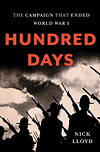
Hundred Days: The Campaign That Ended World War I, by Nick Lloyd, Basic Books, New York, 2014, $29.99
Much has been written about how World War I began, and much else about the seemingly endless and futile struggle in the trenches on the Western Front. Relatively little has been written about the campaign that brought about the end of that conflict. Inspired by the memory of a great uncle killed during the last weeks of what was then known as the Great War, historian Nick Lloyd has produced a new study of the final four months of fighting that decided the outcome of a war which had dragged on in stalemate for four years.
Hundred Days begins in July 1918 with what Lloyd maintains was the war’s true turning point, the Second Battle of the Marne. After Soviet Russia pulled out of the war in 1917, Germany transferred millions of troops from the Eastern Front to the Western Front for a final bid to end the war before the American Expeditionary Forces (AEF) arrived on the scene. During that March–July 1918 offensive the Germans made deep inroads, but they failed to achieve their key objectives—to defeat the Allied armies and take Paris. Moreover, the effort left the German army badly depleted and its newly won front lines dangerously weak. It was at that point, in mid-July, that the Allies, newly reinforced by the Americans, launched a counterattack along the Marne River.
Lloyd maintains that Second Marne represented a whole new phase of warfare on the Western front. Thanks largely to the widespread and effective deployment of tanks, tactical movement replaced the static trench warfare that had predominated for much of the conflict. Gone were the human wave tactics of 1914–17; attacks were instead, states Lloyd, “well thought through…economical; this was the face of war in 1918.”
Under the unified command of French Marshal Ferdinand Foch the Allied war effort had a measure of cohesion. Another new element was the presence of the U.S. Army, which took much of the strain off an exhausted and dispirited French army. “Let the Americans and the tanks take the strain,” French General Henri Philippe Pétain was fond of saying. It was during this period the AEF carried out its successful offensives at Saint-Mihiel and in the Meuse-Argonne.
As the Allies counterattacked with increasing effectiveness, the Germans became increasingly weak and dispirited, yet at Spa, Belgium, far behind the front lines, the German high command remained in a state of denial. In spite of grave reports from the front, Field Marshal Paul von Hindenburg, chief of the German General Staff, put up a brave front, while his micromanaging second-in-command, General Erich Ludendorff, became increasingly erratic and unstable. As early as August 1918 senior members of the cabinet in Berlin were arguing that a military victory was unattainable and that Germany ought to seek a negotiated settlement with the Allies while it remained possible. The military high command overrode any such action.
—Robert Guttman




